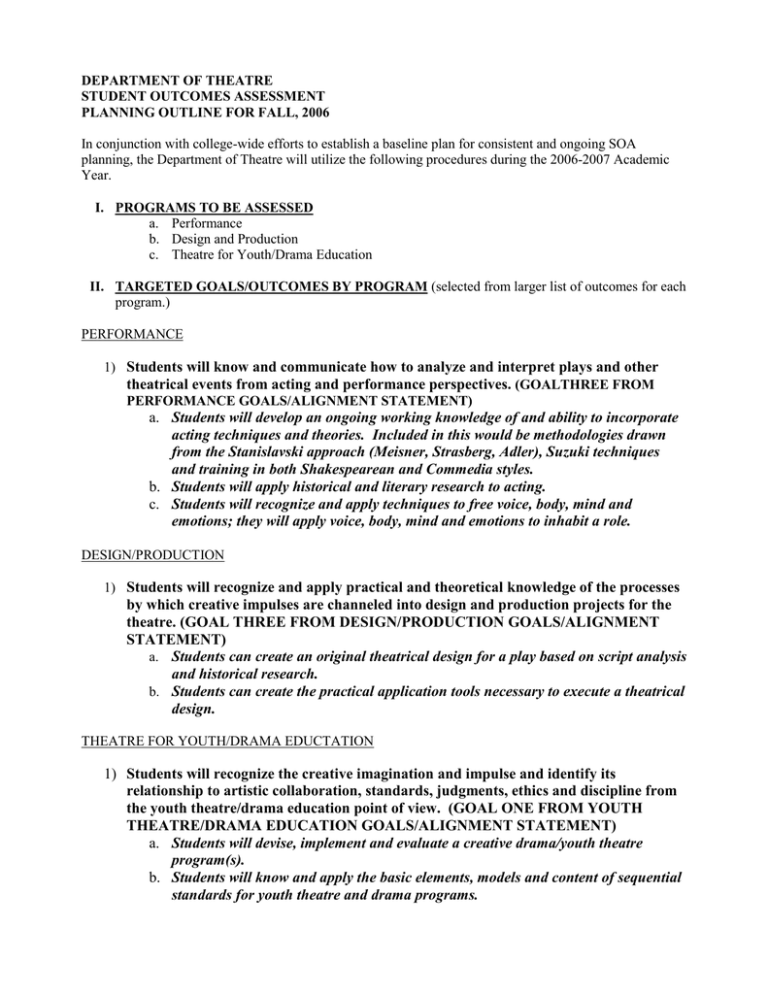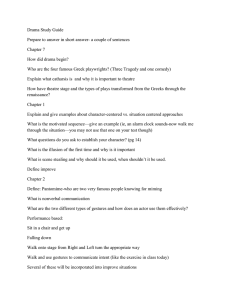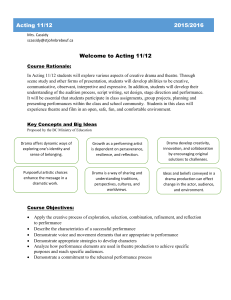DEPARTMENT OF THEATRE STUDENT OUTCOMES ASSESSMENT PLANNING OUTLINE FOR FALL, 2006
advertisement

DEPARTMENT OF THEATRE STUDENT OUTCOMES ASSESSMENT PLANNING OUTLINE FOR FALL, 2006 In conjunction with college-wide efforts to establish a baseline plan for consistent and ongoing SOA planning, the Department of Theatre will utilize the following procedures during the 2006-2007 Academic Year. I. PROGRAMS TO BE ASSESSED a. Performance b. Design and Production c. Theatre for Youth/Drama Education II. TARGETED GOALS/OUTCOMES BY PROGRAM (selected from larger list of outcomes for each program.) PERFORMANCE 1) Students will know and communicate how to analyze and interpret plays and other theatrical events from acting and performance perspectives. (GOALTHREE FROM PERFORMANCE GOALS/ALIGNMENT STATEMENT) a. Students will develop an ongoing working knowledge of and ability to incorporate acting techniques and theories. Included in this would be methodologies drawn from the Stanislavski approach (Meisner, Strasberg, Adler), Suzuki techniques and training in both Shakespearean and Commedia styles. b. Students will apply historical and literary research to acting. c. Students will recognize and apply techniques to free voice, body, mind and emotions; they will apply voice, body, mind and emotions to inhabit a role. DESIGN/PRODUCTION 1) Students will recognize and apply practical and theoretical knowledge of the processes by which creative impulses are channeled into design and production projects for the theatre. (GOAL THREE FROM DESIGN/PRODUCTION GOALS/ALIGNMENT STATEMENT) a. Students can create an original theatrical design for a play based on script analysis and historical research. b. Students can create the practical application tools necessary to execute a theatrical design. THEATRE FOR YOUTH/DRAMA EDUCTATION 1) Students will recognize the creative imagination and impulse and identify its relationship to artistic collaboration, standards, judgments, ethics and discipline from the youth theatre/drama education point of view. (GOAL ONE FROM YOUTH THEATRE/DRAMA EDUCATION GOALS/ALIGNMENT STATEMENT) a. Students will devise, implement and evaluate a creative drama/youth theatre program(s). b. Students will know and apply the basic elements, models and content of sequential standards for youth theatre and drama programs. c. Students will critique and analyze TFY/high school scripts based on elements of dramatic literature. d. Students will know a variety of creative drama and theatre for youth resources. e. Students will select and use research in devised work and scripted production. f. Students will perform, direct and teach activities, productions and roles intended for youth theatre audiences or participants. III. ASSESSMENT STRATEGIES TO BE EMPLOYED PERFORMANCE Students will develop an ongoing working knowledge of and ability to incorporate acting techniques and theories. Included in this would be methodologies drawn from the Stanislavski approach (Meisner, Strasberg, Adler), Suzuki techniques and training in both Shakespearean and Commedia styles. Information to be collected from some or all of the following areas: observation of student’s performance in Practicum/Theatre Production assignments where a role is used for credit; the newly established Practicum grading guidelines that apply to these situations should be considered for this purpose evaluation of student performance in Audition Techniques results of a formal jury/interview experience required of Performance Emphasis students Applies to students who have completed one semester of Acting Studio Nature of assessment process or instrument Mostly self-explanatory as outlined above. The assessment criteria for students using roles for Practicum/Theatre Production credit include having each actor, upon receipt of their role, present a written goal(s) statement to the director in which the actor outlines specific acting skill goals they want to work on using their assigned role; also submission to the director a written evaluation of their success at achieving their acting goals in the production. This self-assessment process may include the acting teacher. Anticipated kinds of information to be received Since acting is a psycho-physical craft, intellectual knowledge will, with varying degrees, precede actual mastery of skills which make up the craft. We will see how well the students know the material and where each student is on the path to mastering the skills that make up the craft. All will have different growth rates in mastering the skills; concentration, imagination, emotional access, identifying and playing an objective, observation, etc., but should have a more uniform knowledge of the skills. DESIGN/PRODUCTION Students can create an original theatrical design for a play based on script analysis and historical research. Information to be collected from some or all of the following areas: Assessment will be embedded in the design courses (Design: Sets, Lights, Costumes) that all Design and Production students are required to take. The presentation will be evaluated by the instructor of the course as well as the Design and Production Committee. Nature of assessment process or instrument Students will develop a portfolio presentation that demonstrates the ability to analyze a script, develop an original design statement for the play, conduct appropriate research to support the design concept and create designs based on that script analysis and research. Students may choose a lighting design, costume design or scenic design. Anticipated kinds of information to be received Can students identify necessary elements required of a design in a play? Can students translate an original design concept into a rendered design? Students can create the practical application tools necessary to execute a theatrical design. Information to be collected from some or all of the following areas: Assessment will be embedded in the design courses (Design: Sets, Lights, Costumes) that all Design and Production students are required to take. Package will be evaluated by the instructor of the course as well as the Design and Production Committee. Nature of assessment process or instrument Students will develop a package of tools required to produce a theatrical lighting, scenic or costume design, including but not limited to: a materials and labor budget, build schedule, pull/rent/buy lists, model and groundplan (scenic design), patterns (costume designs), and light plot (lighting design). Anticipated kinds of information to be received Can students translate a design statement and/or rendering into a practical plan for executing the design THEATRE FOR YOUTH/DRAMA EDUCTATION Students will devise, implement and evaluate a creative drama/youth theatre program(s). Nature of assessment process or instrument Assessment will be embedded in the course, Methods of Teaching Drama and Theatre, which serves as a capstone experience for students in the Youth Theatre emphasis. Process will include the development of a portfolio of student work, based on the Teacher Work Sample template currently endorsed and used by the College of Education, that demonstrates student’s ability to research a topic, design a series of lessons that use drama to teach that topic or skill, and create a rubric or other appropriate assessment tool for analyzing student learning and development. It is anticipated that students will be able to develop a portfolio showcasing their work for three very distinctive kinds of youth theatre teaching environments: a “in-school” program, an “after-school” program and an enrichment program. The portfolio will be scored using the established Teacher Work Sample provided by the College of Education. Scoring will be both peer and instructor. It is anticipated/hoped that 1-2 reviewers from outside the department will score completed portfolio. . Anticipated kinds of information to be received Can students devise a unit of lessons that are aligned with selected drama and theatre outcomes for learning and skill development Can students develop an approach for assessing student learning and program effectiveness





